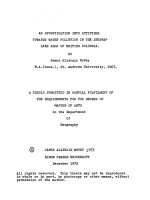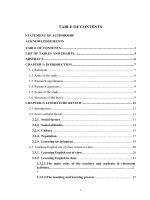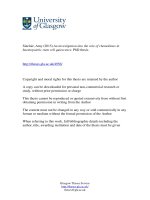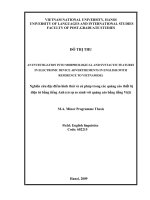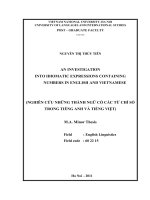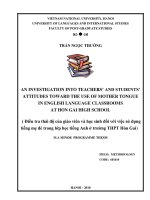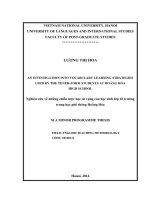An investigation into non-English major students’ motivation in English language learning at Phuong Dong University, Hanoi = Nghiên cứu động lực học tiếng Anh
Bạn đang xem bản rút gọn của tài liệu. Xem và tải ngay bản đầy đủ của tài liệu tại đây (1.43 MB, 67 trang )
VIETNAM NATIONAL UNIVERSITY, HANOI
UNIVERSITY OF LANGUAGES AND INTERNATIONAL STUDIES
FACULTY OF POST-GRADUATE STUDIES
BÙI THỊ PHƢƠNG
AN INVESTIGATION INTO NON-ENGLISH MAJOR
STUDENTS’ MOTIVATION IN ENGLISH LANGUAGE
LEARNING AT PHUONG DONG UNIVERSITY, HANOI
(Nghiên cứu đô
̣
ng lƣ
̣
c học tiếng Anh của các sinh viên
không chuyên tiếng Anh tại Trƣờng Đại Học Dân Lập
Phƣơng Đông, Hà Nội)
M.A. MINOR THESIS
Field : English Teaching Methodology
Code : 6014.0111
HANOI, 2013
VIETNAM NATIONAL UNIVERSITY, HANOI
UNIVERSITY OF LANGUAGES AND INTERNATIONAL STUDIES
FACULTY OF POST-GRADUATE STUDIES
BÙI THỊ PHƢƠNG
AN INVESTIGATION INTO NON-ENGLISH MAJOR
STUDENTS’ MOTIVATION IN ENGLISH LANGUAGE
LEARNING AT PHUONG DONG UNIVERSITY, HANOI
(Nghiên cứu đô
̣
ng lƣ
̣
c học tiếng Anh của các sinh viên
không chuyên tiếng Anh tại Trƣờng Đại Học Dân Lập
Phƣơng Đông, Hà Nội)
M.A. MINOR THESIS
Field : English Teaching Methodology
Code : 6014.0111
Supervisor : Dr. Mai Thị Loan
HANOI, 2013
i
DECLARATION
I certify that this thesis is entirely my own work. Documented references have been
fully provided. I have not been submitted this thesis for assessment in any other
formal course of study.
ii
ACKNOWLEDGEMENT
I would like to express my deep gratitude to my supervisor, D.r. Mai Thi loan for
her support, encouragement and valuable guidance through out the process of
conducting this study.
My special thank is for D.r Le Van Canh and all my other lecturers for their useful
and valuable lectures that I got at the MA course at the University of Languages and
international studies, VNU. I am indebted to them for basic knowledge on teaching
methodology and research methodology.
This study would not have been completed without the participation of non-majored
students and teachers of English at Phuong Dong University. I am grateful for their
sharing time on English learning with me.
Finally, I would like to thank all authors and linguists who have provided me with a
treasure of knowledge about motivation, so that I can have basic theoretical
background for the study.
Without all their help, this thesis would not be completed as expected.
.
Hanoi, 2013
Bui Thi Phuong
iii
ABSTRACT
Motivation has been a concern of so many linguists and scholars for its essential
role in language learning. Discovering learners‟ motivation will help teachers and
educationalists have best methods to help their learners succeed.
The study was conducted with the participation of 300 non-majored students at the
same psychological age group (18-22) from different faculties and 10 teachers at
Phuong Dong University. It is an investigation of non-majored students‟ motivation
at Phuong Dong University with the aim of finding best methods to improve their
motivation in English learning. In order to gain this aim, the study has found out
students‟ desire for learning English, the reasons they are learning English, their
difficulties and their favourite activities and teaching methods in the classroom as
well as teachers‟ suggestions for useful methods. The result showed that non majors
at PDU possess different kinds of motivations with a majority of students learning
English for their future career. Not many of them are satisfied with teaching
facilities and teaching methods at school. They prefer motivational activities such as
games, songs, pictures and some of communicative activities such as listening and
speaking. They also want to practice exercises in the final exams for high marks and
a good degree after graduation. Useful methods applied by teachers are also
investigated for the basis of the most appropriate implications on teaching and
learning English at PDU.
iv
LIST OF CHARTS AND TABLES
Chart 1: Students‟ attitude on English learning at PDU
Chart 2: Students‟ attitude on English
Table 1: Students‟ desire to learn English
Table 2: Students‟ reasons for learning English
Table 3: Factors of learning environment and facilities
Table 4: Factors of teachers and teaching methods
Table 5: Factors of learners‟ problems
Table 6: Students‟ favourite activities and tasks
Chart 3: Teachers‟ roles
Chart 4: English skills focused
Chart 5: Motivational teaching methods
v
ABBREVIATIONS
L2: Second language
PDU: Phuong Dong University
vi
TABLE OF CONTENTS
DECLARATION i
ACKNOWLEDGEMENT ii
ABSTRACT iii
LIST OF TABLES iv
ABBREVIATIONS v
TABLE OF CONTENTS. vi
PART A: INTRODUCTION 1
1. Rationale 1
2. Aims of the study 2
3. Research questions 2
4. Scope of the study 2
5. Method of the study 2
6. Organization of the study 3
PART B: DEVELOPMENT 4
CHAPTER 1: LITERATURE REVIEW 4
1.1. Motivation in language learning 4
1.2. Classification of motivation 6
1.3. Factors affecting students’ motivation 8
1.4. Strategies to motivate students in the classroom 11
1.5. Summary of the chapter 13
CHAPTER 2: THE STUDY 14
2.1. The context of the study 14
2.2. Subjects 15
2.3. Instruments 16
2.4. Data collection and analysis procedure 17
2.5. Summary of the chapter 17
vii
CHAPTER 3: DATA ANALYSIS AND DISCUSSION. 18
3.1. Data analysis of questionnaire for students 18
3.1.1. Students’ motivation 18
3.1.2. Factors affecting students’ motivation 22
3.1.2.1. Learning environment and facilities 22
3.1.2.2. Teachers and teaching methods 24
3.1.2.3. Learner’s problems 26
3.1.3. Students’ favourite activities and tasks 27
3.2. Data analysis of questionnaire for teachers 30
3.3. Summary of the chapter 33
CHAPTER 4: IMPLICATIONS 34
4.1. Teachers’ roles, responsibility and awareness 34
4.1.1. Teachers’ roles 34
4.1.2. Teachers’ enthusiasm and responsibility 35
4.1.3. Teachers’ awareness of students’ interest and expectations in the
class 35
4.2. Motivational teaching methods 35
4.2.1. Warm-up activities and visual aids 35
4.2.2. Variety of activities 36
4.2.3. The revision book 37
4.2.4. Focus on listening and speaking skills 37
4.2.5. Further activities and worksheets 38
4.2.6. Clear instruction and explanation about the goals of each activity
and lesson 38
4.2.7. Winning cards 39
4.3. Some other proposals to improve students’ motivation in English
learning at PDU 39
viii
4.3.1. Teaching facilities 39
4.3.2. Teacher education programs 40
4.3.3. English contests, outdoor activities and English club 40
4.4. Summary of the chapter 40
PART C: CONCLUSION 41
1. Summary of the study 41
2. Recommendations for further researches 42
REFERENCES 44
APPENDICES I
1
PART A. INTRODUCTION
1. Rationale
English, as an international language, is widely used in most fields in most countries
in the world nowadays. Among them, Vietnam has been aware of the importance of
English to improve economic development and enhance international relationships.
It is undeniable that English is the bridge to introduce Vietnamese culture and
people to others in the world. In the first place, Vietnamese people started learning
English as a requirement of their job and nowadays they learn for different
purposes. Some learn English for their future jobs; some learn English for their
desire to discover knowledge and some may want to learn English for their interest.
For university students, English is a compulsory subject as well as job requirement
after graduation. However, as my experience at PDU, not all my students like
English and not many of them satisfy with English lessons in the classroom. It is
obvious that the effectiveness of teaching and learning English in schools should be
taken into account.
It is said that teaching is one of the easiest jobs in the world but teaching well is one
of the most difficult. It is no doubt that everyone can tell others what he or she
knows but not so many can become good teachers because teaching in general and
teaching language in particular always requires a large effort from the teacher. In
fact, teachers always have to face with a number of problems in the class. One of
the difficulties most English teachers have experienced when teaching is students‟
passivity to learn the language in the class. The answers to some questions such as
how to counter with students‟ lack of effort, desire and motivation in learning
English, how to get don‟t want to learn learners involved in classroom activities
need to be based on students‟ expectations in language classes. Moreover, an
understanding about their motivation to learn and factors negatively affecting their
motivation will be the key to this problem.
Motivation is not a new term in the language-teaching field and many studies by
scholars, linguistics and educationalists have proved that motivation is an important
2
aspect of successful learning. Therefore, they attempt to find out the most useful
ways to motivate students in the class. However, effectiveness and application of
these methods always vary in different contexts. In fact, up to now, there has not
been any research on non-majors‟ motivation at Phuong Dong University, one of
the oldest private universities in Ha Noi in which, as my experience, students‟
motivation in learning English is quite different from other schools.
For all the reasons above, this study is hoped to reveal student‟s motivation as well
as factors influencing their motivation in the class so that pedagogical implications
can be drawn to help students more interested in learning English.
2. Aims of the study
The study aims at investigating non-English major students‟ motivation in English
learning at PDU and proposing professional implications on how to support teachers
in motivating non- English learners to learn English.
3. Research questions
To achieve above aims the study will answer following questions
1) What kinds of motivation do non-English major students at PDU possess?
2) What factors negatively affect non-English major students’ motivation in
English learning at PDU?
3) What are their favourite activities and tasks in the English class?
4) What implications can support teachers to improve students’ motivation to learn
English?
4. Scope of the study
The study is an investigation of motivation in English learning of first year and
second year non- English major students at PDU only and then some useful
implications for teachers to make students more motivated in the English class will
be suggested.
5. Method of the study
To achieve the aim of the study, the study is carried out by following steps:
3
- First, a survey questionnaire for students was conducted to investigate students‟
motivation in English learning, factors affecting motivation and expectations in
the English class at PDU.
- Second, a survey questionnaire for teachers was delivered to investigate
teachers‟ opinions about some motivational tools as well as useful methods they
are applying to motivate their students in the classroom.
- Then data were collected, sorted and analyzed quantitatively to explore non-
majors‟ motivation
- Last, some pedagogical implications for improving students‟ motivation in
learning English were suggested at the end of the study.
6. Organization of the study
The thesis consists of three main parts:
PART A- Introduction: provides general introduction of the study with the
rational, the aims, the research questions, the scope, the method and the
organization of the study.
PART B- Development: is divided into four chapters:
Chapter 1 discusses theoretic backgrounds that are relevant to the study such as
different views on motivation in language learning, the importance of motivation in
language learning, kinds of motivation, factors affecting learners‟ motivation and
strategies enhancing motivation in foreign and second language learning.
Chapter 2 presents the context of the study, data collection instruments and
procedure of data collection.
Chapter 3 describes the process of collecting data and the detail analysis of the
collected data from which some findings, explanation and interpretation of the
findings of the study are presented.
Chapter 4 discusses some pedagogical implications on how to motivate non-
majored students in learning English at PDU.
PART C: Conclusion: summarizes what have been done in the study and presents
some possible suggestions for the further researches. The references and appendices
are also included in this final part.
4
PART B: DEVELOPMENT
CHAPTER 1: LITERATURE REVIEW
In this chapter, a review of some of the aspects of the concept of motivation such as
definition, classifications, roles and factors affecting learners‟ motivation will be
provided. Several motivating tools for language learning suggested by various
theorists and practitioners will be also briefly presented and discussed.
1.1. Motivation in language learning
Motivation is something internal to human beings. It drives human beings to act. It
is also related to satisfaction of needs and desire of human beings to perform or
achieve a goal. „To motivate‟ means “to make somebody want to do something,
especially something that involves hard work and effort” (Oxford Advance
Learners‟ Dictionary)
In language learning, motivation refers to learners‟ desire and effort to achieve the
goals of getting good results in tests or being more successful in future career. It is
undeniable that motivation is particularly important in education in general and in
the classroom in particular because of its strong impact on students‟ learning. As a
critical component of learning, motivation is essential in getting students to engage
in academic activities. It is also important to determine how much students will
learn from the activities they perform or the information to which they will be
exposed to.
Researchers have different views on the term of motivation in language teaching
and learning. Many of these motivation theories are based on goal achievement
where people are motivated by the prospect of success.
Harmer (1983: 3) has a broad view of motivation: motivation is some kind of
internal drive that encourages somebody to pursue a course of action. He also
mentions another important term of motivation: goal. He explains that if we
perceive a goal and if that goal is sufficiently attractive, we will be strongly
motivated to do whatever is necessary to reach that goal.
5
Beside Harmer, other researchers also attempt to explain what motivation is. Thus,
motivation to learn a foreign language can be describe as a complex of construct,
involving effort and desire, as well as favorable attitude toward learning the
language in hand (Gardner, 1985). It is a tool to explain why people decide to do
something, how hard they are going to pursue it, and how long they are willing to
sustain the activity (Dörnye, 2001). It is also a complex phenomenon and includes
many components such as the individual‟s drive, need for achievement and success,
curiosity, desire for stimulation and new experience, and so on (Littlewood,
1998:53).
Regarding to motivation in the teaching-learning process, it is stated that students
will work longer, harder and with more vigor and intensity when they are motivated.
Bernaus (1995, 11-20) after investigating the role of motivation in foreign language
learning has founded that „motivation accounts for 48.5% of students‟ English
proficiency‟ and concluded that motivation is the main factor affecting students‟
foreign language acquisition, followed by socio-cultural factor. He also emphasized
that the motivational factors are more important than other factors in favouring
students‟ English achievement.
Littlewood (1998:53) also states that in second language learning, motivation is the
crucial force which determines whether a learner embarks on a task at all, how
much energy he devote to it, and how long he perseveres.
Another role of motivation is to promote the choice of strategies to become
successful in academic activities. The use of specific learning strategies and
techniques while studying a second language leads to success. According to Oxford
(1994), “more motivated students tend to use more strategies than less motivated
students, hence, they tend to be more successful”.
In general, motivation can be understood as a desire to achieve a goal, combined
with the energy to work towards that goal. In the classroom, this theory is
confirmed by the fact that the students pursue the goal to gain some kinds of
rewards such as praise, grades, scholarships, certificates, diplomas, good job and so
6
on. However, learners‟ motivation can change overtime and have effect on their
language.
1.2. Classification of motivation
Most researchers (Gardner and Lambert: 1959, Harmer: 1983, Dörnyei: 1998)
divided motivation into two types: integrative and instrumental motivation.
According to Gardner and Lambert (1959), the integrative motivation refers to a
desire to become more like valued members of the target language community. it is
based on interest in learning the second language because of their need to learn
about, associate or socialize with the people who use it or because of purpose or
intention to participate or integrate in the second language using the same language
in that community. As pointed by Harmer (1983: 3), the strong form of integrative
motivation wishes to integrate himself into the target culture and a weak form of
such motivation would be the students‟ desire to know as much as possible about
the culture of the target language community.
On the other hand, the instrumental motivation concerns practical values in learning
the second language such as passing exams, financial rewards, furthering a career or
gaining promotion (Harmer: 1983; Gardner and Lambert: 1959). It is a
determination to acquire another language to achieve such goals as a good job or
social recognition (Gardner and Lambert, 1959).
In fact, it is difficult to attribute learning language success to certain integrative or
instrumental because integrative and instrumental motivations are mutually
inclusive. Most situations in learning language involve a mixture of each type of
motivation (Dörnyei, 1998). The importance of integrative and instrumental
motivation depends on situations or contexts, whether learning language functions
more as a foreign language or as a second language (Gardner and Lambert, 1959)
Another popular view on types of motivation divided motivation into extrinsic and
intrinsic motivation.
According to Harmer (1983: 3) extrinsic motivation is related to the concept of
goal. He explains that students who decide to go and study a language to obtain
7
some goal that they wish to reach. Extrinsic motivation is based on external
outcomes such as rewards and punishment. This motivation could bring a negative
impact to the students, because with extrinsic motivation, students do not learn with
their strong intention or will but they study it because they are pushed by the
interest in the rewards or the punishment.
Intrinsic motivation refers to the motivation to engage in an activity because that
activity is enjoyable and satisfying to do. He states that „intrinsic motivation plays
by far the larger part in most students‟ success or failure as language learner‟.
Because this type of motivation is from within the students, they are always
willingly and voluntarily try to learn what they think it is worth or important for
them. When students have intrinsic motivation, they have the internal desire to learn
without the need for external outcomes.
Kathleen Bailey (1986, quoted in Brown, 2000: 165-166) illustrated the relationship
between the intrinsic-extrinsic construct and integrative-instrumental orientation
with the diagram:
Intrinsic
Extrinsic
Integrative
L2 learner wishes to
integrate with the L2
culturen(e.g., marriage or
immigration)
Someone else wishes the L2
learner to know the L2 for
integrative reasons (e.g., Japanese
parents send kids to Japanese-
language school)
Instrumental
L2 learner wishes to achieve
goals utilizing L2 (e.g, for a
career)
External power wants L2 learner
to learn L2 (e.g., corporation
sends Japanese businessman to
U.S for language training)
It is obvious that different kinds of motivation are closely related to each other.
They do not exclude each other. According to Gilakjani, Lai-Mei Leong and
Sabouri (2012), „it is hard to consider motivation as something that is either simply
internal or external to the learner‟ because „intrinsic and extrinsic motivation is
8
relevant to integrative and instrumental motivation in relation to L2 language
learning‟. They explain: learners who study hard to learn L2 may be intrinsically or
extrinsically motivated or many have a mixture of both intrinsic and extrinsic
reasons prompting them. As extrinsic motivation may turn out to be integrative
motivation if someone else wishes the L2 learner to know the L2 for integrative
reasons; extrinsic motivation could turn out to be instrumental motivation if an
external power wants the L2 learner to learn the L2 language. In addition, intrinsic
motivation can turn out to be integrative motivation and intrinsic motivation can
also turn out to be instrumental motivation if the L2 learner wishes to achieve goals
utilizing L2. The learners with similar instrumental motivation might show a
striking difference between intrinsic and extrinsic motivation. Similarly, the learners
with the same integrative motivation can show vast differences of intrinsic and
extrinsic motivation.
1.3. Factors affecting students’ motivation
Some researchers have presented and analyzed factors affecting motivation. Most
these views agree that most common factors include teacher‟s factors, learners‟
factors and physical factors. Among these theories, I support Harmer and Dornyei‟s
view on factors influencing negatively and positively on extrinsic and intrinsic
motivation.
According to Harmer (1983), the factor affecting extrinsic motivation most is
students‟ attitude toward the language. This attitude may be influenced by those
around him who have positive or negative attitude to the culture or the target
language community or by his previous experiences as a student.
He also states factors that can affect intrinsic motivation as follows:
Physical condition: physical conditions have a great effect on learning and can alter
a student‟s motivation either positively or negatively. For example if student have to
study in the bad lighting classroom, overcrowded with too many students, have to
look at the small board, or in the unpleasant smell classroom, they can lose their
motivation or their motivation in learning will be lowered.
9
Method of teaching: the ways that students are taught must have some effects on
their motivation. Whenever the learners feel bored with the teacher‟s method, their
motivation would likely be lost or gradually decreased, whereas, if they are
interested in the teaching method, they will find it motivating.
The teacher: Teachers are considered as the most powerful variable of motivation
and demotivation, and can become a major part in demotivating the learners. Denis
Girard (1970, cited in Harmer, 1983:5-6) suggested some qualities a teacher should
have to help in providing intrinsic motivation:
- The teacher has to make his classes interesting
- The teacher must be fair, treat his students equally and as far as possible
understand and act on the worries and aspirations of his pupils.
- The teacher must offer a good model as the target language user
- The teacher must be a good technician…
Success: Success plays a vital part in the motivation drive of a student. It refers to
the appropriate level of challenge designed by the teachers. If the difficulty of work
and activity is too high or too low, it can lead students to a demotivated situation in
learning. As Harmer (1983:6) pointed out, to give high challenge activities may
have a negative effect on motivation. Students can also equally be demotivated by
too low level of challenge.
Dornyei (1994: 279-280) also studied the possible factors of demotivation among
English language learners focused on the role of effective factors at three levels of
language, learner and learning situation. His study showed that the learners‟
demotivation concerned with the learner levels and learning situation levels. One of
the learners‟ problems is lack of self-confidence, caused mostly by negative past
experiences and some of learning situation level problems are being placed into an
inappropriate group; lack of free choice, lack of skilled teachers and lack of
constancy in language learning in a relaxing and pleasant atmosphere.
10
Moreover, Dornyei (2001, cited in Ghadirzadeh, Hashtroudi, Shokri, 2012)
presented nine demotivating factors based on his studies about the possible factors
of demotivation:
- Teachers‟ personalities, commitments, competence, teaching methods
- Inadequate school facilities (large class sizes, unsuitable level of classes or
frequent change of teachers)
- Reduced self-confidence due to their experience of failure or lack of success
- Negative attitude toward the foreign language studied
- Compulsory nature of the foreign language study
- Interference of another foreign language that pupils are studying
- Negative attitude toward the community of the foreign language spoken
- Attitudes of group members
- Course books used in class
Related to the relationship between demotivation factors and the strength of
motivation, Ghadirzadeh, Hashtroudi, Shokri (2012) when studying demotivating
factors for English language learning among university students, attempted to
answer the question: “Is there any significant difference between the two groups of
more and less motivated students for English language learning?” The results of
multivariate analysis of variance showed statistically significant differences
between the two groups for two factors (lack of perceived individual competence
and lack of intrinsic motivation) while there were no statistically significant
differences for the other three demotivating factors (inappropriate characteristics of
teachers‟ teaching methods and course contents, inadequate university facilities and
focus on difficult grammar).
Among all these factors, teachers and teaching methods are considered the most
important ones that affect students‟ motivation negatively or positively because in
the class, the teacher always has to play different roles such as a leader, a supporter
an encourager etc. The way the teacher encourages students definitely affects
students‟ motivation the most.
11
1.4. Strategies to motivate students in the classroom
The question of how to motivate students to learn always calls the concern from
many teachers and researchers. According to Dornyei.Z. and H-F. Cheng (2007),
motivation is one of the key factors that determine success in L2 learning, strategies
in motivating language learners should be seen as an important aspect of the
theoretical analysis of L2 motivation. Generally, they agree that extrinsic and
intrinsic motivation should be combined, but teachers should target at the intrinsic
motivation as the main long-term motivation to students‟ learning.
Dörnyei (1998b) offered a set of Ten Commandments for motivating learners. All
these these ten items focus on what the teacher can and should do to stimulate
intrinsic motivation:
1) Set a personal example with your own behavior
2) Create a pleasant, relaxed atmosphere in the classroom
3) Present the task properly
4) Develop a good relationship with the learners
5) Increase the learner‟s linguistic self-confidence.
6) Make the language classes interesting
7) Promote learner autonomy
8) Personalize the learning process
9) Increase the learners‟ goal-orientedness
10) Familiarize learners with the target language culture
Dörnyei (2001, cited in Gardner.R and Bernaus.M, 2008) then grouped these
strategies into four categories:
- Creating basic motivational conditions by adopting appropriate teacher
behaviours, having a good relationship with students, maintaining a pleasant and
supportive atmosphere in the classroom.
- Enhancing learners' language-related values and attitudes, increasing their
expectancy of success, increasing their goal-orientedness.
12
- Improving the quality of learning experience, increasing students‟ self-
confidence, creating learner autonomy…
- Encouraging positive self-evaluation by promoting attributions to effort rather
than to ability, providing motivational feedback and increasing learner
satisfaction.
Brown (2001: 82) introduces guidelines to teachers to motivate students
intrinsically.
- Teachers‟ role: the role of teachers is emphasized as enablers, not rewarders.
That means teachers should not use too many tangible or immediate rewards. It
is better if they stimulate students‟ self-determination and self-satisfaction. The
rewards should be only the supplementary motivated resource when necessary.
And it is advisable that teachers help learners set some personal goals and
learning strategies to reach these goals.
- Teaching approaches: Brown then suggests some teaching approaches that are
considered intrinsic motivation such as learner-centered, cooperative and
content-based teaching. Instead of providing learners with all the necessary
things to learn, the teacher gives them opportunities to make choices in activities,
topics and discussions, etc.
- Test: he also mentions the importance of test with some special intentions from
teachers with the potential of intrinsic motivation. The tests should involve
students‟ input and are face-valid in the eyes of students.
Oxford and Shearin (1996: 139) also offer practical suggestions for teachers to
motivate students. According to him, teachers can motivate students by identifying
why they are studying the new language and help them shape their own belief about
success and failure in second language learning. They also need to make the L2
classroom a welcoming, positive place where psychological needs are met and
where language anxiety is kept to a minimum. Besides, teachers can urge students
to develop their own intrinsic rewards through positive self-talk, guided self-
13
evaluation, and mastery of specific goals, rather than comparison with other
students.
As far as many a educationalist are concerned, the ratio of using intrinsically and
extrinsically motivated ways in teaching depends on many other factors such as
teachers‟ teaching style, the students‟ age and characteristics, the stages of the
lesson and so on. The right of choosing the appropriate methods and strategies are
in hand of the teacher. Many factors involved in the success of applying motivating
resources, but some notes like young learner‟s preference and needs should be taken
into account.
1.5. Summary of the chapter
The chapter has reviewed some knowledge related to motivation theory in language
teaching and learning. It has provided the basic understanding about the general
views of motivation, kinds of motivation, factors affecting motivation as well as
strategies to motivate students in the classroom. Based on this knowledge, an
investigation of non-majored students‟ motivation at PDU will be introduced in the
next chapter.
14
CHAPTER 2: THE STUDY
This chapter will present the context of the study and research methodology
including subjects, instruments and data collection and analysis procedure.
2.1. The context of the study
Founded in 1994, Phuong Dong University is one of the oldest private universities
in Ha Noi. At the present, there are over 9000 students placed in 6 different fields
including Foreign Languages, Economics and Management, Electrical Engineering,
Information Technology, Architecture and Environment Technology. The main
campus in Trung Kinh Street is training about 6000 students of four departments:
Foreign Languages, Economics and Management, Information Technology and
Environment Technology. The school has a library on the seventh floors serving
reference materials for students and but non-majors have no chance to learn English
with projectors. There are also four computer rooms serving information technology
courses and examination.
At Phuong Dong University, non-English major students have to learn English as a
compulsory subject. They are required to complete four general English terms in the
first year and second year and an ESP term in the third year. Each English class has
from 20 two 35 students. At the end of each term, students are always examined on
four skills including listening, speaking, reading and writing. Most first year
students‟ level of English proficiency ranges from beginning to pre- intermediate
level. When they were at high school, they got used to translation grammar teaching
method in which the teachers focused on the rules of grammar structures and
students practiced the drills to remember those structures. Therefore, at university,
most students have difficulties in listening and speaking skills.
Among 21 teachers of English currently teaching non-majors at the main campus in
Trung Kinh street, 15 of them got the MA degrees. They are all female ranking
from 24 to 45 and have at least two years teaching non-majors at PDU.
The textbooks used in general English courses are New Headway series (the third
edition) by Liz and John Soars. Two first terms deal with the Elementary book and
15
the two later terms learn the pre-intermediate book. Because of the final
examination format, students are always required to practice and complete all
language skills during the course including listening, speaking, writing, reading
comprehension and language forms. Besides, practicing and working in pairs and
groups are of the most popular activities in the class to prepare for the final
speaking test.
2.2. Subjects
The study was first conducted with the participation of 325 first and second year
students randomly chosen from different departments representing 3000 first year
and second year students of PDU. Among them, there are 75 students from
Information Technology, 100 students from Environment Technology and 150
students from Economics and Management Department. The majority of students
are aged from 18 to 22. They come from different backgrounds and environments,
varied from the cities to mountainous areas. Some students are living in the central
Hanoi. Most of them have been learning English for at least 7 years but enrolled the
course with low and medium level of English proficiency.
These groups of students are chosen for the study for the two following reasons:
First, only first year, second year and third year students are required to learn
General English at PDU. A study on first year and second year students who have
just completed the first and second term of English is ideal to understand their
reasons for learning English and plan strategies for improving their motivation in
later terms.
Secondly, a study on students sharing the same type of drives and condition of
learning but differing in learning majors and styles can help define the different
levels and kinds of motivation more sufficiently. The number of students from the
faculty of economics and management are bigger than those of any other faculty at
PDU and assumed to learn English better than others and seem to be more
interested in English. Most of them have higher level of language proficiency than
those from other departments because English is one of their main subjects at the

